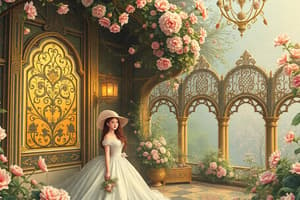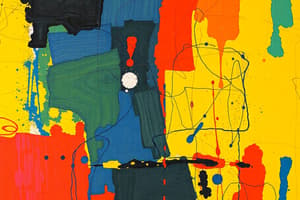Podcast
Questions and Answers
What are the major categories of arts?
What are the major categories of arts?
Visual Arts, Performing Arts, Literary Arts, and Applied Arts.
What is the expressive function of arts?
What is the expressive function of arts?
It communicates emotions, thoughts, and social commentary.
Name one historical movement in arts and its focus.
Name one historical movement in arts and its focus.
Impressionism, which focuses on capturing light and atmosphere.
What role do the arts play in mental health?
What role do the arts play in mental health?
Give an example of an applied art form.
Give an example of an applied art form.
Who is Maya Angelou and what is she known for?
Who is Maya Angelou and what is she known for?
What contemporary issue impacts the arts today?
What contemporary issue impacts the arts today?
What does the cultural function of arts reflect?
What does the cultural function of arts reflect?
What is the significance of arts in fostering community?
What is the significance of arts in fostering community?
Identify an important figure in arts and their contribution.
Identify an important figure in arts and their contribution.
Flashcards are hidden until you start studying
Study Notes
Definition of Arts
- Arts encompass a range of human activities involving the creation of visual, auditory, or performance artifacts.
- These artifacts express the creator's imagination, conceptual ideas, or technical skill.
Major Categories of Arts
-
Visual Arts
- Includes painting, drawing, sculpture, photography, and architecture.
- Focuses on the creation of works that are primarily visual in nature.
-
Performing Arts
- Encompasses theater, dance, music, and opera.
- Involves live performance and often combines various elements like movement, speech, and sound.
-
Literary Arts
- Comprises written works, poetry, prose, and drama.
- Explores storytelling, expression, and the use of language.
-
Applied Arts
- Refers to art forms that apply design and aesthetics to functional objects.
- Examples include graphic design, fashion design, and interior design.
Functions of Arts
- Expressive Function: Communicates emotions, thoughts, and social commentary.
- Cultural Function: Reflects and preserves cultural values, traditions, and identity.
- Educational Function: Promotes learning and understanding of different perspectives.
- Recreational Function: Provides enjoyment and entertainment.
Historical Context
- Arts have evolved over time, influenced by sociopolitical contexts, technological advancements, and cultural exchanges.
- Major movements include the Renaissance, Baroque, Romanticism, Modernism, and Postmodernism.
Significance of Arts
- Enhances cognitive development and creativity.
- Fosters community and social connection.
- Plays a role in mental health and well-being through therapeutic practices.
Contemporary Issues in Arts
- Funding and access to arts programs.
- The impact of digital media and technology on traditional forms of art.
- Discussions about representation, diversity, and equity in the arts.
Notable Art Forms and Movements
- Impressionism: Focus on capturing light and atmosphere.
- Cubism: An abstract approach using geometric shapes and multiple perspectives.
- Surrealism: Exploration of dreams and the unconscious mind.
- Street Art: Graffiti and urban art as forms of social and political expression.
Important Figures in Arts
- Leonardo da Vinci: Renowned for his contributions to painting and science.
- Shakespeare: Influential playwright and poet whose works shaped literature.
- Maya Angelou: Poet and civil rights activist known for her impactful literature.
Conclusion
- Arts serve as a vital aspect of human expression and culture.
- Understanding and appreciating various art forms enhances cultural literacy and empathy.
Definition of Arts
- Arts are human activities that involve creating visual, auditory, or performance artifacts.
- These artifacts express the creator's imagination, ideas, or technical skill.
Major Categories of Arts
- Visual Arts: Includes painting, drawing, sculpture, photography, and architecture.
- Performing Arts: Encompasses theater, dance, music, and opera.
- Literary Arts: Comprises written works, poetry, prose, and drama.
- Applied Arts: Refers to art forms that apply design and aesthetics to functional objects, like graphic design, fashion design, and interior design.
Functions of Arts
- Expressive Function: Arts communicate emotions, thoughts, and social commentary.
- Cultural Function: Arts reflect and preserve cultural values, traditions, and identity.
- Educational Function: Arts promote learning and understanding.
- Recreational Function: Arts provide enjoyment and entertainment.
Historical Context
- Arts have evolved throughout history, influenced by social, political, technological, and cultural changes.
- Major art movements include the Renaissance, Baroque, Romanticism, Modernism, and Postmodernism.
Significance of Arts
- Arts enhance cognitive development and creativity.
- Arts foster community and social connection.
- Arts play a vital role in mental health and well-being through therapeutic practices.
Contemporary Issues in Arts
- Funding and access to arts programs are major concerns.
- Digital media and technology impact traditional art forms.
- Representation, diversity, and equity in the arts are ongoing discussions.
Notable Art Forms and Movements
- Impressionism: Focused on capturing light and atmosphere.
- Cubism: An abstract approach using geometric shapes and multiple perspectives.
- Surrealism: Explored dreams and the unconscious mind.
- Street Art: Graffiti and urban art are forms of social and political expression.
Important Figures in Arts
- Leonardo da Vinci: Renowned for his contributions to painting and science.
- Shakespeare: Influential playwright and poet whose works shaped literature.
- Maya Angelou: Poet and civil rights activist known for her impactful literature.
Conclusion
- Arts are a vital aspect of human expression and culture.
- Understanding and appreciating various art forms enhances cultural literacy and empathy.
Studying That Suits You
Use AI to generate personalized quizzes and flashcards to suit your learning preferences.




